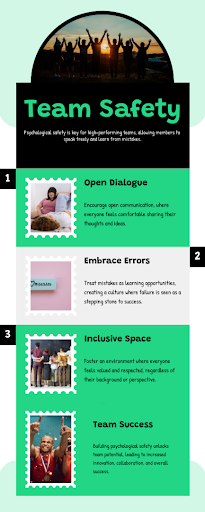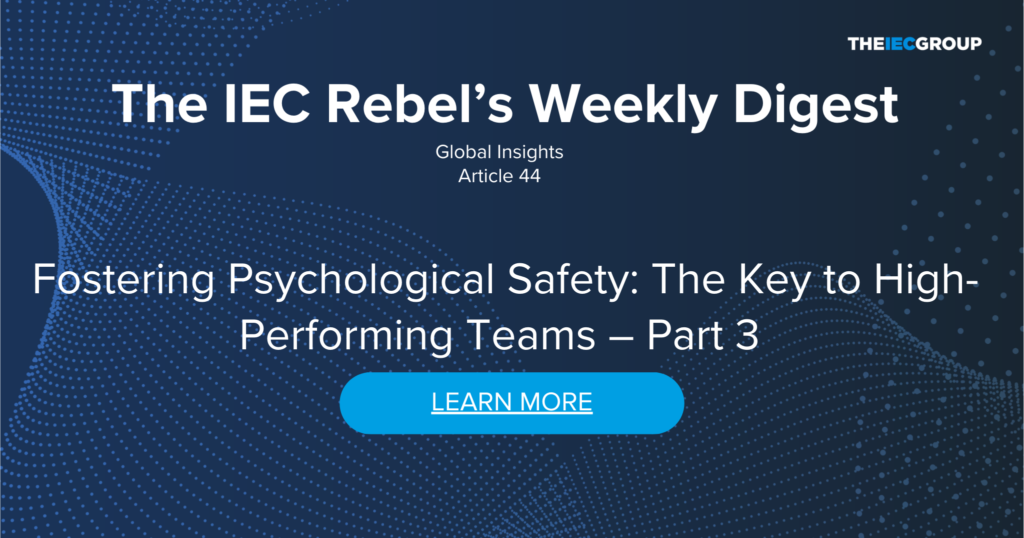Embracing Experimentation: Encouraging Risk-Taking and Innovation
Introduction
 In our previous article, we explored the dynamics of building high-performing teams, using Bruce Tuckman’s model to guide teams from Forming to Performing. Now, we turn our attention to one of the most critical components for unlocking high performance: psychological safety.
In our previous article, we explored the dynamics of building high-performing teams, using Bruce Tuckman’s model to guide teams from Forming to Performing. Now, we turn our attention to one of the most critical components for unlocking high performance: psychological safety.
Coined by Harvard professor Amy Edmondson, psychological safety refers to a shared belief that the team environment is safe for interpersonal risk-taking. When team members feel psychologically safe, they are more likely to speak up, share ideas, and engage in productive conflict—all essential ingredients for innovation and long-term success. In this article, we’ll explore the importance of psychological safety and provide practical strategies for fostering it within your team.
Why Psychological Safety Matters
Psychological safety is foundational for team success. Teams that foster psychological safety experience:
- Increased Innovation: When people feel safe to speak up without fear of punishment or ridicule, they share creative ideas, suggest new approaches, and take risks that can lead to breakthrough innovations.
- Enhanced Collaboration: In a psychologically safe environment, team members trust each other and are more likely to collaborate openly, leveraging diverse viewpoints and expertise to solve complex problems.
- Better Problem-Solving: Teams that are comfortable discussing mistakes or challenges are better equipped to learn from them and improve. Psychological safety helps teams address issues head-on rather than sweeping problems under the rug.
- Higher Engagement and Well-being: Employees who feel safe are more engaged, motivated, and committed to their work. This creates a positive work environment, reducing burnout and turnover.
Creating Psychological Safety: Practical Strategies
Fostering psychological safety is an ongoing process that requires intentional actions from leaders and team members alike. Below are actionable strategies that can help build and sustain a psychologically safe team environment.
- Lead by Example: Model Vulnerability and Openness
Leaders set the tone for psychological safety. By being open about your own challenges, mistakes, or uncertainties, you create a space where team members feel comfortable doing the same. When leaders show vulnerability, it signals that everyone is human, and mistakes are part of the learning process.
Key Actions for Leaders:
- Admit your mistakes and share lessons learned with the team.
- Acknowledge when you don’t have all the answers and seek input from the team.
- Encourage open discussion around difficult topics without judgment.
- Promote Open Dialogue: Encourage Questions and Feedback
A psychologically safe environment is one where everyone feels empowered to ask questions, offer feedback, and voice their ideas, even if they might challenge the status quo. It’s important to create a culture where feedback flows freely, both from leaders to employees and between peers.
Key Actions for Leaders:
- Regularly ask for feedback on team processes, decisions, and leadership.
- Hold “open forums” or feedback sessions where team members can voice concerns.
- Acknowledge and act on feedback to show that it is valued and taken seriously.
- Normalize Mistakes as Learning Opportunities
Teams that embrace mistakes as learning opportunities rather than failures create a psychologically safe environment. When errors happen, encourage reflection and collective problem-solving rather than placing blame. This shifts the focus from fault to improvement.
Key Actions for Leaders:
- After a project, hold a “lessons learned” meeting to discuss what went well and what could be improved.
- Celebrate team achievements, but also highlight the value of the learning process when things don’t go as planned.
- Create a “no blame” culture where the focus is on finding solutions, not assigning fault.
- Foster Inclusivity and Active Listening
Psychological safety thrives in environments where everyone feels heard and valued. Leaders should ensure that all voices—especially those of quieter or minority team members—are invited to participate in discussions. Inclusivity ensures that diverse perspectives are brought to the table, fostering better decision-making.
Key Actions for Leaders:
- In meetings, actively invite input from all team members, especially those who may hesitate to speak up.
- Practice active listening by acknowledging and reflecting on what others have said before responding.
- Encourage team members to be mindful of inclusive behaviors and avoid interrupting or dismissing others’ ideas.
- Address Conflicts Constructively
In psychologically safe teams, conflict is viewed as a necessary and healthy part of team dynamics. However, how conflicts are addressed determines whether they contribute to growth or cause harm. Teach team members to engage in constructive conflict where disagreements are discussed respectfully, focusing on ideas rather than personal attacks.
Key Actions for Leaders:
- Provide training on conflict resolution and constructive feedback.
- Encourage team members to voice differing opinions and facilitate discussions to resolve conflicts productively.
- Remain neutral and fair when mediating disputes, ensuring all perspectives are considered.
- Create a Safe Space for Experimentation
High-performing teams innovate by experimenting and testing new ideas, but experimentation involves risk. Create an environment where team members feel empowered to try new approaches without fear of punishment if things don’t work out.
Key Actions for Leaders:
- Encourage the team to experiment with new ideas and approaches, even if they’re unconventional.
- Reward effort, initiative, and creativity—even when experiments fail.
- Emphasize the learning that comes from trying new things, whether or not the outcome is successful.
Measuring Psychological Safety in Your Team
To ensure that psychological safety is a reality in your team, it’s important to continuously assess and improve it. Here are a few ways to measure psychological safety:
- Surveys and Feedback: Conduct anonymous surveys to ask team members how safe they feel to speak up, share ideas, and make mistakes.
- Observe Team Interactions: Pay attention to how often team members voice opinions, engage in discussions, and challenge ideas. A silent or disengaged team might indicate low psychological safety.
- Review Team Learning: Monitor whether your team learns from mistakes and reflects on their processes. Teams that avoid discussing failures may lack psychological safety.
Conclusion
Psychological safety is a cornerstone of high-performing teams. By fostering an environment where team members feel safe to speak up, take risks, and collaborate without fear of judgment, you unlock the full potential of the group. Through openness, inclusivity, and a focus on learning, your team can not only excel but also innovate and adapt in today’s fast-paced world.
In the next article, we’ll dive deeper into strategies for building trust within teams—another crucial element in creating high-performance cultures.
Stay tuned!
Go To’s: Here are the key “Go To’s” after reading the article:
- Promote Openness: Encourage team members to speak up and share ideas without fear of judgment.
- Model Vulnerability: Lead by example by admitting mistakes and fostering a culture of transparency.
- Create Feedback Loops: Regularly ask for and act on feedback to build trust and improve team dynamics.
- Embrace Mistakes: Turn mistakes into learning opportunities rather than assigning blame.
- Foster Inclusivity: Ensure all voices are heard and valued, especially quieter or minority perspectives.
- Encourage Constructive Conflict: Promote healthy discussions to resolve disagreements and foster growth.
- Provide Safe Spaces for Experimentation: Empower your team to try new ideas without fear of failure.
Introducing the IEC Knowledge Network Free Membership – Your Gateway to Seamless Access!
We are thrilled to present a new service that goes beyond the ordinary download experience. In addition to offering you the ability to download the things you love, we are delighted to introduce the IEC Knowledge Network Free Membership.
The Free Membership option grants you access to our library of articles and videos, without the need for tedious registrations for each piece of content.
The publication serves as a trusted resource to support executives in their pursuit of sustainable and successful global expansion. In addition the IEC Practitioners are available to discuss your specific challenge in more detail and to give you clear advise..
Take advantage of this valuable resource to accelerate your global expansion journey


